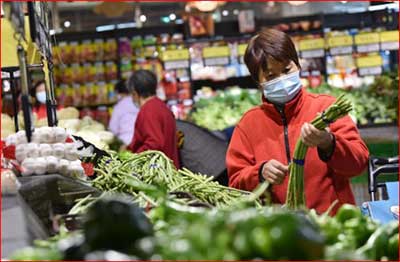Date: 10/11/2022
Relevance: GS-3: Indian Economy and issues relating to planning.
Key Phrase: Unprecedented slowdown, Housing bubble, Rivalry with the US, import bill, semiconductors, Stagflation, Inflation.
Context:
- From the nine per cent year-on-year growth for more than four decades to less than three per cent now, China braces for an unprecedented slowdown.
Key Highlights:
- The 2022 World Bank GDP growth projection for China is 2.8 per cent.
- The average growth rate data for its Asia-Pacific neighbours is 5.3 per cent.
- Thus, China is estimated to grow at half the rate than that of its neighbours.
- While most economies suffer due to global factors, the Chinese slowdown is largely caused by its own acts of commission.
- When China slows down, it buys less, consumes less, and produces less affecting all suppliers and buyers worldwide.
Key Terms:
- Slowdown: A slowdown, on the other hand, means that the pace of the GDP growth has decreased. It means the production and earnings of these economies are not growing at the same pace as, say, last year.
- Recession: A recession is a business cycle contraction when there is a general decline in economic activity. Recessions generally occur when there is a widespread drop in spending (an adverse demand shock).
- Stagflation: Stagflation is the simultaneous appearance in an economy of slow growth, high unemployment, and rising prices.
Roots of slowdown
The three crucial factors leading to slowdown are –
- Zero Covid policy:
- Covid-19 pandemic led to a shutdown of many manufacturing and shipping facilities disrupting supplies starting early 2020s.
- Zero Covid policy forced citizens to stay indoors, affecting jobs and incomes.
- Till August 2022, at least 20 cities contributing to 10 per cent of China’s GDP were under lockdown.
- Housing bubble:
- The housing sector accounts for a quarter of the Chinese GDP.
- The failure of Evergrande Group, China’s second-largest housing firm, to meet offshore debt obligations precipitated the housing crisis.
- Developers abandoned semi-finished buildings, founders sold their stakes, exited the groups, forcing homebuyers not to pay the mortgage.
- Housing loan default may lead to a crisis in banking as banks lent $7.5 trillion or a quarter of all bank loans to housing.
- The housing bubble wiped out most gains of the hard-working Chinese middle class.
- Rivalry with the US:
- With China growing more assertive and belligerent, the US sees it as a threat to US technology and military supremacy.
- With exports of $435 billion and imports of $125 billion, China has a trade surplus of $310 billion with the US.
- The new US export control rules blocked chip makers worldwide from developing advanced chips for China.
A Look at the high value of China’s major global exports:
- Electronic products ($900 billion), Machinery ($550 billion), Textiles and apparel ($310 billion), Steel products ($160 billion), Furniture ($150 billion), Plastics ($130 billion), Automobiles ($120 billion), Toys ($100 billion), Medical equipment ($100 billion).

(The figure in the bracket shows China’s export value in 2021.)
- The world buys most laptops, mobile phones, washing machines, refrigerators, apparel, toys, and household goods from China.
- Green energy transition will be expensive if China supplies fewer photovoltaic cells or Electric Vehicle batteries.
- The US, EU, and India may face a health emergency without China. Each buys most (>70 per cent) of the APIs KSM from China.
Impacts of the Slowdown:
- Reduced commodity and energy prices:
- China’s lower crude oil, natural gas, and coal consumption will reduce energy prices worldwide.
- Crude sells at the sub-100 level at $95/barrel. OPEC may cut production to contain falling prices.
- But for now, the lower prices of crude oil, natural gas, and coal will reduce the import bill.
- Australia and Brazil suffer as significant value of their mining and agriculture produce went to China.
- Less business with China imperils their economies.
- Increase in the prices of semiconductors:
- Prices have increased more than 50 per cent within the past six months.
- This will lead to an increase in the prices of cars, laptops, and all things electronics. Expect delayed supplies and further price rises.
- Impetus to local manufacturing:
- The Covid-19 pandemic made the world see that it cannot put all its eggs in the China basket.
- Countries like the US are investing billions of dollars in the Make in America program to cut dependence on China for medicines, semiconductors, green energy, and critical materials.
- High US dollar interest rates:
- China invests about $1 trillion from its $3.2 trillion reserves in US treasury bonds.
- Low export earnings may compel China to invest less in treasury bonds forcing the US Fed to increase interest rates to make bonds attractive.
- This would mean fewer dollars in the market, leading to fewer new investments in the US and the world.
Impact on India:
- The China slowdown has led China to buy less and sell more to India.
- The January-August 2022 DGCI&S data confirms this trend. China’s share in India’s exports decreased from 6.5 per cent in January-August 2021 to 3.5 per cent in January-August 2022.
- Share in India’s imports remains broadly the same at 15 per cent.
- There is no let-up on the trade deficit due to the slowdown.
- On the positive side, India will gain from active relocation by large global firms looking for China+1 option.
Conclusion:
- Xi Jinping continues as General Secretary of the Chinese Communist Party for the third time, concentrating ever more power at the top. This may help in dealing with local issues.
- But, how China deals with the US restrictions on high technology items will ultimately decide its future as an industrial and military power.
Source: The Hindu BL
Mains Question:
Q. Why there is slow down in Chinese economy, and how will it affect the world, India? (250 Word).








